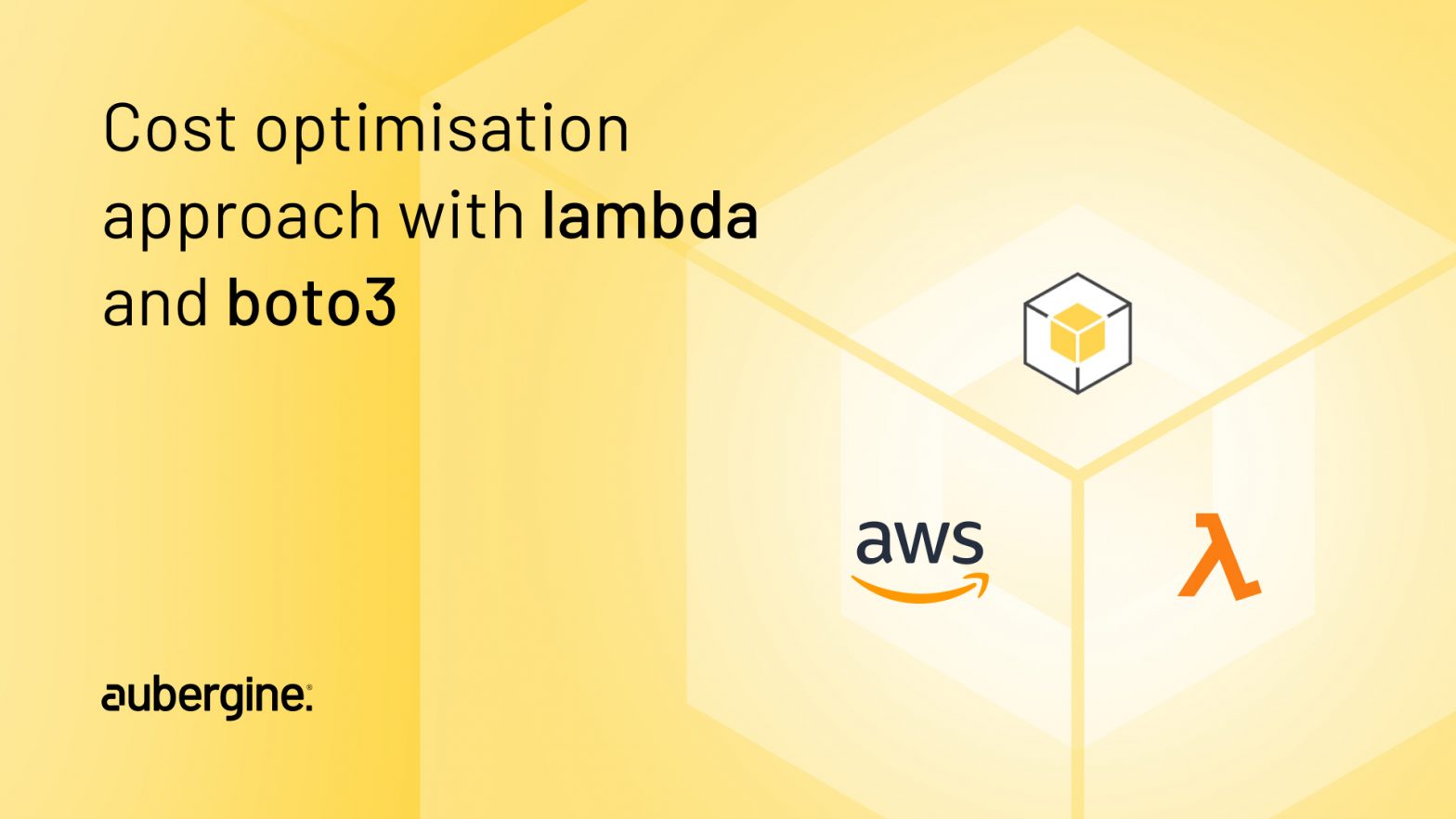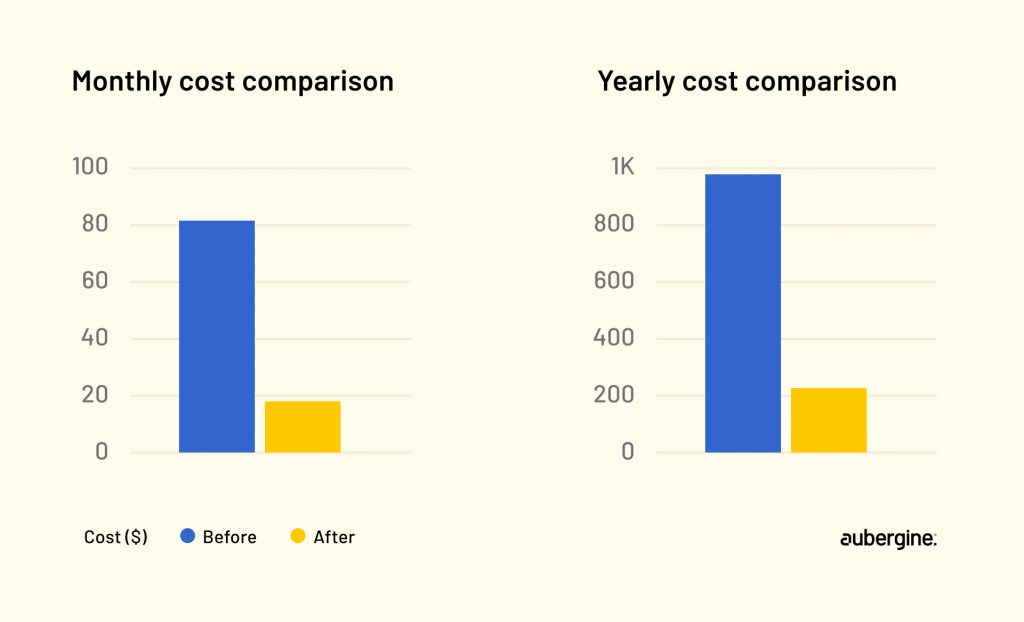
In the landscape of cloud computing, Aubergine distinguishes itself by pioneering cost optimization strategies on the AWS Cloud, notably through the integration of the Boto3 library with Lambda functions.
This blog explores Aubergine’s dual-pronged approach to cost management, highlighting two critical strategies: precision resource scheduling and advanced database management. It illustrates how Aubergine leverages the Boto3 library—a Python SDK for AWS services—to orchestrate these strategies effectively.
Aubergine’s resource scheduling strategy epitomizes efficiency and cost savings, driven by an automated system that manages the initiation and termination of resources with unmatched precision.
Aubergine’s resource scheduling strategy is at top of efficiency and cost savings, driven by an automated system that orchestrates the initiation and termination of resources with precision.
Central to Aubergine’s strategy are Lambda functions that utilize Boto3 to manage AWS resources.
These functions are designed to start and stop EC2 instances and RDS databases in alignment with operational hours, ensuring that resources are only active when needed. This approach not only prevents wasteful spending during off-hours and weekends but also exemplifies Aubergine’s dedication to resource optimization.
Consider the following sample code for a Lambda function:
python
import boto3
# Function to start an RDS instance
def start_rds_instance(db_instance_identifier):
rds_client = boto3.client('rds')
try:
response = rds_client.start_db_instance(DBInstanceIdentifier=db_instance_identifier)
print(f"RDS instance {db_instance_identifier} starting...")
except Exception as e:
print(f"Error starting RDS instance: {e}")
# Function to start an EC2 instance
def start_ec2_instance(instance_id):
ec2_client = boto3.client('ec2')
try:
response = ec2_client.start_instances(InstanceIds=[instance_id])
print(f"EC2 instance {instance_id} starting...")
except Exception as e:
print(f"Error starting EC2 instance: {e}")
# Sample Lambda handler
def lambda_handler(event, context):
# Start resources and send notification
# Replace placeholders with actual values
These Lambda functions, triggered by CloudWatch Events, are not only efficient in managing resource states but also provide a granular level of control that aligns with Aubergine’s commitment to resource optimization.
Aubergine has augmented its approach to resource management by incorporating automated email notifications for changes in resource states, powered by Boto3 within its Lambda functions. This enhancement is designed to bolster both transparency and accountability throughout the organization.
Utilizing Amazon Simple Email Service (SES), these automated notifications inform team members about the start and stop events of resources in real-time. This system ensures that all relevant stakeholders are kept in the loop, even during non-working days, thereby mitigating the risk of unintended resource usage and the subsequent financial implications.
By integrating these notifications, Aubergine has established a more connected and informed operational environment, where every team member is promptly updated on critical resource changes. This not only prevents unnecessary expenditures but also fosters a culture of responsibility and awareness regarding cloud resource management.
Aubergine has taken its cost optimization strategy a step further by focusing on database management, where it has realized substantial financial benefits through strategic consolidation. This approach involves merging several SQL databases into one Amazon RDS (Relational Database Service) instance, simplifying management while maintaining the same level of functionality and performance for internal projects.
In our ongoing quest to enhance efficiency and reduce expenses, we’ve developed a method that significantly lowers the costs associated with Amazon RDS instances. This method consolidates multiple databases into a single RDS instance. Moreover, by employing automated start-stop mechanisms through AWS Lambda functions for this consolidated RDS instance, we’ve managed to streamline operations and cut down on unnecessary expenditure.
This smart consolidation, coupled with automation, has led to a remarkable cost reduction of about 65%. Such savings underscore the effectiveness of proving that managing databases more intelligently can lead to substantial financial gains without sacrificing operational excellence. Aubergine’s approach demonstrates a balance between cost efficiency and maintaining high performance, setting a benchmark for cost-conscious database management in the cloud.
Aiming for superior cost efficiency, Aubergine has refined its infrastructure strategy by merging three smaller instances into one larger, more powerful instance. This strategic consolidation has effectively tackled various operational hurdles while setting the stage for considerable cost reductions. Alongside this consolidation, we expanded the Elastic Block Store (EBS) volume, ensuring a smooth integration of resource files.
This transition to a singular, more capable instance has led to optimized resource use, simplifying our operational framework and enhancing system performance across the board. Such a move represents a deliberate shift towards an infrastructure that’s not only less complex but also more cost-efficient, highlighting our commitment to leveraging technology for smarter, more economical cloud management.
Also read: Amazon CloudFront tutorial: comprehensive overview & successful setup guide

When evaluating the cost optimization features of AWS against its competitors, Google Cloud Platform (GCP) and Microsoft Azure, it’s essential to understand the unique offerings and strengths each provider brings to the table.
AWS’s strength lies in its extensive collection of cost management tools, designed to give users granular control over their cloud expenses.
GCP distinguishes itself with sustained use discounts and the ability to customize machine types, offering flexible pricing models that cater to varying workload demands.
Azure excels in integrating with other Microsoft products and services, offering cost optimization benefits particularly attractive to enterprises heavily invested in the Microsoft ecosystem
AWS continues to lead in cloud computing innovation, with new strategies and technologies for cost optimization on the horizon. Here’s what to watch:
Also read: Complete guide to deploying your React app on AWS EC2 for global accessibility
Aubergine’s approach, combining Boto3 and Lambda functions for AWS management, marks a significant leap in cloud computing efficiency and innovation.
This achievements in cutting operational costs and improving how resources are used serves as a guide for companies dealing with the complexity of cloud management. As cloud technology evolves, Aubergine’s methods highlight the critical role of smart cost management and the opportunities it creates for sustainable success using AWS.
This blog aims to show how targeted technology use can bring real change, offering a clear lesson: smart innovation in cloud computing can significantly reduce costs and increase efficiency, pointing to a future where achieving cost-effective cloud operations is a reachable goal for everyone.
Looking to build the future of digital ecosystems? Let’s talk.

